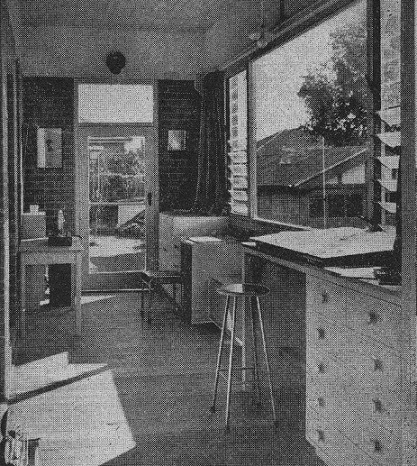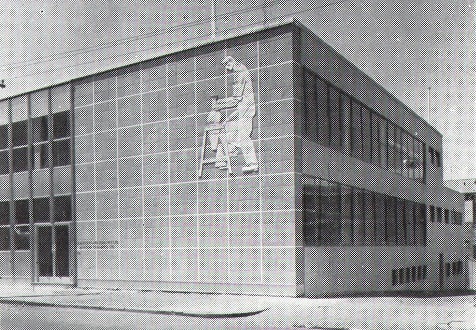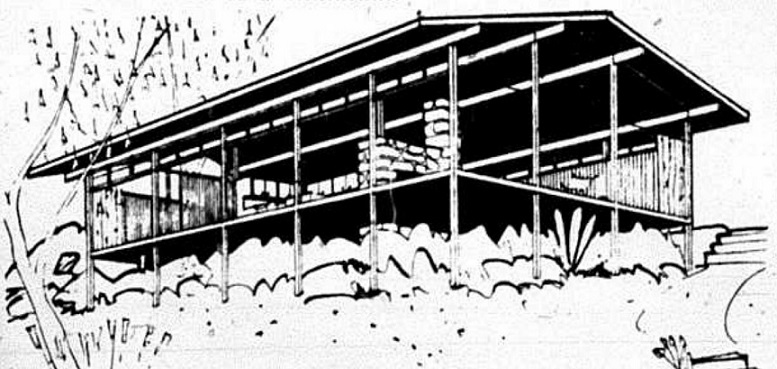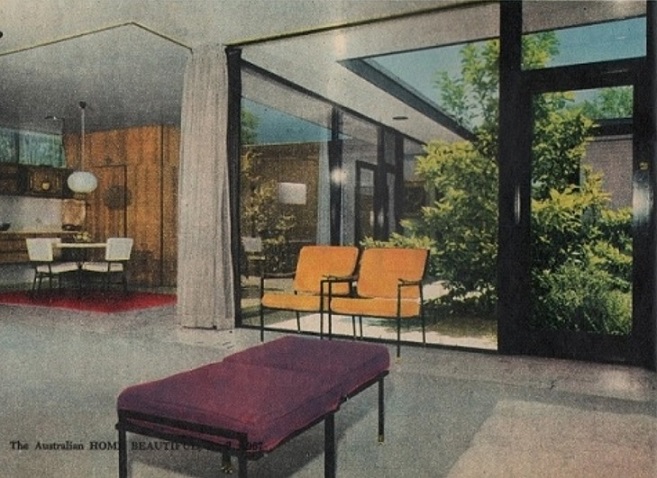Born in the Sydney suburb of Cremorne on 13 April 1917, Alfred
Robert (Bob) Van Rompaey was the eldest son of Leslie Sydney Joseph van
Rompaey (1891-1962) and the former Gertrude Maud Augusta Abrecht
(1889-1967). A woolbuyer by trade, Leslie Van Rompaey continued the
successful business (formerly Messrs Ostermeyer, Dewes, Van
Rompaey & Company) founded by his Belgian-born father,
Alfred senior, in the 1880s. Leslie and Gertrude married in
Victoria in 1915 and, although their first son was born
in Sydney, the family was living in Hawthorn by the time
that a second son, Gerald, was born in 1921. A daughter, Pamela,
soon followed. In 1924, the growing family relocated
to Camberwell, taking up residence in a large
house designed for them by the leading inter-war partnership
of Barlow & Hawkins. This commission came about through
a
family connection, as Gertrude Van Rompaey's younger sister, Irena
(1893-1968), had married the firm's founder, Marcus Barlow
(1890-1954), in 1918.
Robert Van Rompaey attended Melbourne Boys' Grammar School and, in December 1934, was awarded the annual William Cain Prize for Drawing. In August 1940, he enlisted with the Australian Army and served with the Land Headquarters before being discharged in December 1945 with the rank of Sergeant. During the intervening years, in February 1943, he married Elizabeth Mary Coote (1916-2007), a leading Melbourne soprano well-known for her performances in opera, oratorio and requiem. After the war, Van Rompaey gained a position in the office of Rhys Hopkins (1910-1996) at 314 Collins Street, and was still there when he registered as an architect in October 1947. By then, he had already made other connections in the profession, as his application was endorsed by leading Melbourne practitioners Otto Yuncken (of the firm then still known as Yuncken, Freeman, Freeman & Griffiths), as well as by his uncle, Marcus Barlow. In May 1948, Van Rompaey was admitted as an Associate of the RVIA. By 1950, he had transferred to Barlow's office, which was then located in a converted corner pub in West Melbourne.
In December 1952, van Rompaey and his wife left for an extended European tour during which he intended to "study design and building techniques in Great Britain and on the Continent" while she was to further her operatic training under Arnold Matters, a leading Covent Garden baritone. At the time of their departure, it was reported that a "final bon voyage" would be held in the form of an open house at van Rompaey's parents' new residence in Balwyn, which he had recently designed for them. The couple returned, via Columbo and Sydney, in September 1953.
Following Marcus Barlow's death in 1954, his practice continued as Barlow, Van Rompaey & Kerr. It carried out a number of high-profile commercial projects, most notably a small factory and showroom in Queen Street for a ceramic company run by another of Barlow's relatives. By the end of the decade, after Van Rompaey had left to open his own office, the name of the firm was abridged to Barlow & Kerr.
Van Rompaey's best-known solo project was the house at Camberwell that he designed for himself, his wife, their two young sons and his widowed mother-in-law, Mrs A E Coote. The site, formerly part of the grounds (and tennis court) of an adjacent Victorian villa, was small and set well back from the street. Van Rompaey overcame these difficulties with a smart flat-roofed and glass-walled house on a compact courtyard plan, and remodelled a remnant 1890s outbuilding as a separate dwelling for Mrs Coote. Known as White Lodge, the house was much published in the architectural and popular press. In 1966, it was profiled in the Australian Women's Weekly as one of the first entries in its new "House of the Week" column. The following year, it appeared both on the front cover of the Australian Home Beautiful, and in Architecture in Australia.
In the 1970s, Van Rompaey resumed partnership with Rhys Hopkins, his erstwhile employer from more than three decades before. The firm, however, ceased in 1976; as Van Rompaey himself noted, "a victim of the economic recession". He spent the new few years "freelancing from home", as he put it, and, in 1979, advised the Architects' Registration Board that he intended to "do the rounds of the drafting services in the forlorn hope of doing some work". He maintained his registration as an architect until January 1983, and died ten years later.
Robert Van Rompaey attended Melbourne Boys' Grammar School and, in December 1934, was awarded the annual William Cain Prize for Drawing. In August 1940, he enlisted with the Australian Army and served with the Land Headquarters before being discharged in December 1945 with the rank of Sergeant. During the intervening years, in February 1943, he married Elizabeth Mary Coote (1916-2007), a leading Melbourne soprano well-known for her performances in opera, oratorio and requiem. After the war, Van Rompaey gained a position in the office of Rhys Hopkins (1910-1996) at 314 Collins Street, and was still there when he registered as an architect in October 1947. By then, he had already made other connections in the profession, as his application was endorsed by leading Melbourne practitioners Otto Yuncken (of the firm then still known as Yuncken, Freeman, Freeman & Griffiths), as well as by his uncle, Marcus Barlow. In May 1948, Van Rompaey was admitted as an Associate of the RVIA. By 1950, he had transferred to Barlow's office, which was then located in a converted corner pub in West Melbourne.
In December 1952, van Rompaey and his wife left for an extended European tour during which he intended to "study design and building techniques in Great Britain and on the Continent" while she was to further her operatic training under Arnold Matters, a leading Covent Garden baritone. At the time of their departure, it was reported that a "final bon voyage" would be held in the form of an open house at van Rompaey's parents' new residence in Balwyn, which he had recently designed for them. The couple returned, via Columbo and Sydney, in September 1953.
Following Marcus Barlow's death in 1954, his practice continued as Barlow, Van Rompaey & Kerr. It carried out a number of high-profile commercial projects, most notably a small factory and showroom in Queen Street for a ceramic company run by another of Barlow's relatives. By the end of the decade, after Van Rompaey had left to open his own office, the name of the firm was abridged to Barlow & Kerr.
Van Rompaey's best-known solo project was the house at Camberwell that he designed for himself, his wife, their two young sons and his widowed mother-in-law, Mrs A E Coote. The site, formerly part of the grounds (and tennis court) of an adjacent Victorian villa, was small and set well back from the street. Van Rompaey overcame these difficulties with a smart flat-roofed and glass-walled house on a compact courtyard plan, and remodelled a remnant 1890s outbuilding as a separate dwelling for Mrs Coote. Known as White Lodge, the house was much published in the architectural and popular press. In 1966, it was profiled in the Australian Women's Weekly as one of the first entries in its new "House of the Week" column. The following year, it appeared both on the front cover of the Australian Home Beautiful, and in Architecture in Australia.
In the 1970s, Van Rompaey resumed partnership with Rhys Hopkins, his erstwhile employer from more than three decades before. The firm, however, ceased in 1976; as Van Rompaey himself noted, "a victim of the economic recession". He spent the new few years "freelancing from home", as he put it, and, in 1979, advised the Architects' Registration Board that he intended to "do the rounds of the drafting services in the forlorn hope of doing some work". He maintained his registration as an architect until January 1983, and died ten years later.
Select List of Projects
A R Van Rompaey
| 1949 1952 | Additions to own residence, Marlborough Street, Mont Albert Residence for parents, 294 Union Road, Balwyn |
Barlow, Van Rompaey & Kerr
| 1955 1956 1958 | Showroom for F R Barlow & Sons, 310 Queen Street, Melbourne Office building for Victoria Insurance Company Ltd, Moorabool Street, Geelong Bank branch for ES&A Bank Ltd, Mildura Bank branch for ES&A Bank Ltd, Blackburn Road, Blackburn Additions to infant welfare centre, 12 Civic Square Croydon Residence, Shoreham |
A R Van Rompaey
| 1966 | Residence for self, 16b Waterloo Street, Camberwell Residence (Kalangadoo), Wooralla Drive, Mount Eliza |
 | |
| A R van Rompaey's home studio, Mont Albert (1949) |
 | |
| Factory and showroom for F R Barlow & Company, Queen Street, Melbourne (Barlow, van Rompaey & Kerr, 1954) |
 | |
| House, Shoreham (Barlow, van Rompaey & Kerr, 1958) |
 | |
| A R van Rompaey's own house at Camberwell (1966) |
